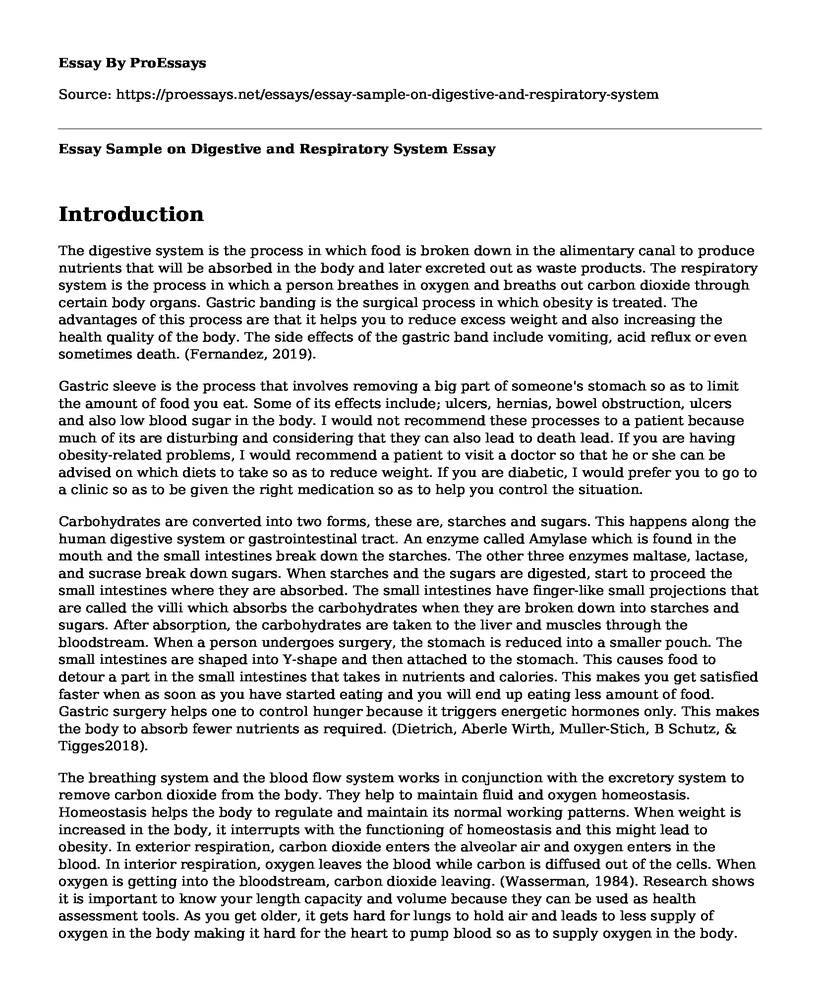Introduction
The digestive system is the process in which food is broken down in the alimentary canal to produce nutrients that will be absorbed in the body and later excreted out as waste products. The respiratory system is the process in which a person breathes in oxygen and breaths out carbon dioxide through certain body organs. Gastric banding is the surgical process in which obesity is treated. The advantages of this process are that it helps you to reduce excess weight and also increasing the health quality of the body. The side effects of the gastric band include vomiting, acid reflux or even sometimes death. (Fernandez, 2019).
Gastric sleeve is the process that involves removing a big part of someone's stomach so as to limit the amount of food you eat. Some of its effects include; ulcers, hernias, bowel obstruction, ulcers and also low blood sugar in the body. I would not recommend these processes to a patient because much of its are disturbing and considering that they can also lead to death lead. If you are having obesity-related problems, I would recommend a patient to visit a doctor so that he or she can be advised on which diets to take so as to reduce weight. If you are diabetic, I would prefer you to go to a clinic so as to be given the right medication so as to help you control the situation.
Carbohydrates are converted into two forms, these are, starches and sugars. This happens along the human digestive system or gastrointestinal tract. An enzyme called Amylase which is found in the mouth and the small intestines break down the starches. The other three enzymes maltase, lactase, and sucrase break down sugars. When starches and the sugars are digested, start to proceed the small intestines where they are absorbed. The small intestines have finger-like small projections that are called the villi which absorbs the carbohydrates when they are broken down into starches and sugars. After absorption, the carbohydrates are taken to the liver and muscles through the bloodstream. When a person undergoes surgery, the stomach is reduced into a smaller pouch. The small intestines are shaped into Y-shape and then attached to the stomach. This causes food to detour a part in the small intestines that takes in nutrients and calories. This makes you get satisfied faster when as soon as you have started eating and you will end up eating less amount of food. Gastric surgery helps one to control hunger because it triggers energetic hormones only. This makes the body to absorb fewer nutrients as required. (Dietrich, Aberle Wirth, Muller-Stich, B Schutz, & Tigges2018).
The breathing system and the blood flow system works in conjunction with the excretory system to remove carbon dioxide from the body. They help to maintain fluid and oxygen homeostasis. Homeostasis helps the body to regulate and maintain its normal working patterns. When weight is increased in the body, it interrupts with the functioning of homeostasis and this might lead to obesity. In exterior respiration, carbon dioxide enters the alveolar air and oxygen enters in the blood. In interior respiration, oxygen leaves the blood while carbon is diffused out of the cells. When oxygen is getting into the bloodstream, carbon dioxide leaving. (Wasserman, 1984). Research shows it is important to know your length capacity and volume because they can be used as health assessment tools. As you get older, it gets hard for lungs to hold air and leads to less supply of oxygen in the body making it hard for the heart to pump blood so as to supply oxygen in the body. When the heart is forced for a long time, it may fail, leading to heart failure or even sometimes death to the individual.
References
Belachew, M., Legrand, M. J., Defechereux, T. H., Burtheret, M. P., & Jacquet, N. (1994). Laparoscopic adjustable silicone gastric banding in the treatment of morbid obesity. Surgical Endoscopy, 8(11), 1354-1356.
Fernandez Jr, A. Z. (2019). 9 Bariatric Surgery. Nutrition and Diabetes: Pathophysiology and Management, 149.
Quanjer, P. H., Tammeling, G. J., Cotes, J. E., Pedersen, O. F., Peslin, R., & Yernault, J. C. (1993). Lung volumes and forced ventilatory flows.
Schwartz, M. W., Woods, S. C., Seeley, R. J., Barsh, G. S., Baskin, D. G., & Leibel, R. L. (2003). Is the energy homeostasis system inherently biased toward weight gain?. Diabetes, 52(2), 232-238.
Wasserman, K. (1984). Coupling of external to internal respiration. American Review of Respiratory Disease, 129(2P2), S21-S24.
Dietrich, A., Aberle, J., Wirth, A., Muller-Stich, B., Schutz, T., & Tigges, H. (2018). Obesity Surgery and the Treatment of Metabolic Diseases. Deutsches Arzteblatt International, 115(42), 705.
Cite this page
Essay Sample on Digestive and Respiratory System . (2022, Dec 11). Retrieved from https://proessays.net/essays/essay-sample-on-digestive-and-respiratory-system
If you are the original author of this essay and no longer wish to have it published on the ProEssays website, please click below to request its removal:
- Paper Example on Banning Horse-Drawn Carriages From the Street of New York City
- Essay Sample on Atrioventricular and Semilunar Valves
- Stem Cell and Designer Babies Essay Example
- Research Paper on Critical Habitat for the Candy Darter
- Essay Example on the Edward Memorial Zoological Garden: Gorillas Walking Like Men
- Essay Example on the Next Decade: Human Augmentation & Global Challenges
- Gene Transfer: Enhancing Agriculturally Significant Species - Paper Sample







